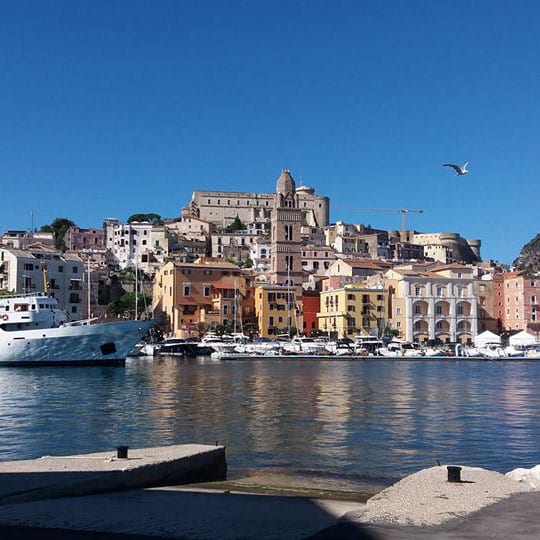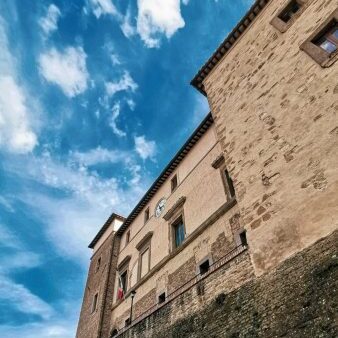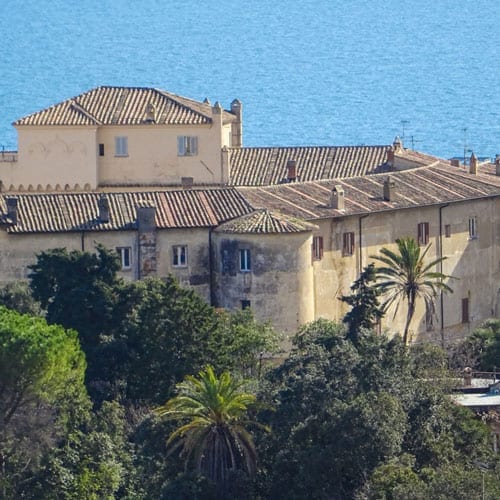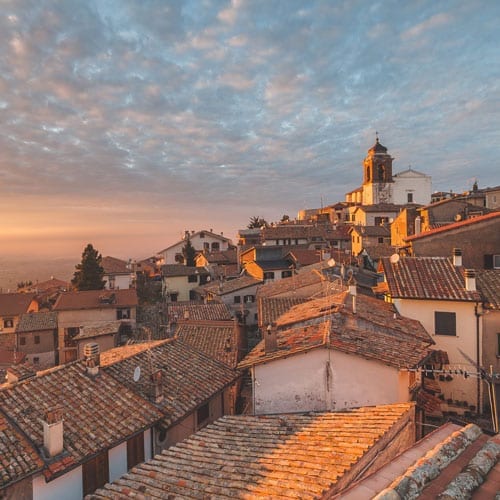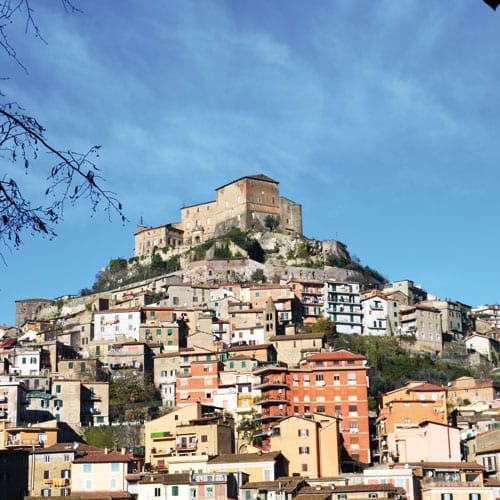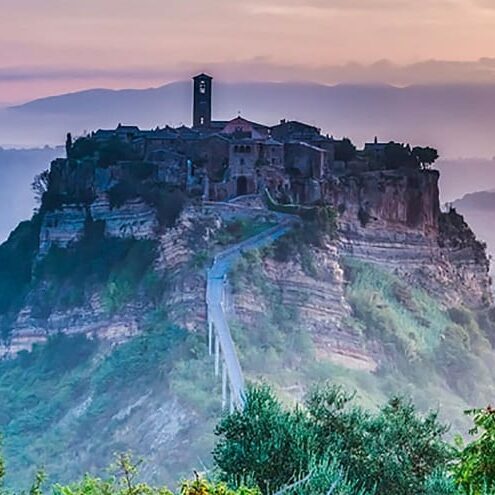 Atina
Atina
MUNICIPALITY OF Atina
(Province of Frosinone)
Altitude
mt. 490 a.s.l.
POPULATION
4557 (500 in the borgo)
info turismo
Pro Loco Atina “Dr. Carmelo Ferraro”
Piazza Garibaldi, 26
Ph. 0776 609309
Atina and Valle di Comino Archeological Museum “G. Visocchi”
Via Vittorio Emanuele II
Ph. 0776 628100 – 349 2603957
museoatina@gmail.com
www.comune.atina.fr.it
www.facebook.com/ComuneAtina
 The Name
The Name
The origins of the name are uncertain and can be traced back to various roots, including ‘attin’, ‘ant’, ‘at’ from which “alto”(high), in reference to the altitude of the place, but it could also derive from the Greek “Athena” or from the name given to it by the god Saturn, in memory of his nephew Anitinus.
According to legend, Atina was founded by Saturn, the god of Olympus, who, forced to flee from Greece, hid in Lazio where he gave birth to a fabulous “golden age”, founding five large and fertile cities, including Atina. The village was famous for the nickname “potens” that Virgil gave it maybe for the metalfileds located in the area.
Precious evidence of Atina’s flourishing past are the mighty polygonal walls (4th century BC) which, with their perimeter of about six kilometres, are among the largest in the Italic world.
We enter the village for a pleasant walk through elegant squares, monumental arches and precious Roman epigraphs, set in the ancient palaces’ façades. The Municipality of Atina consists of three main settlements: the Old Town, with elegant eighteenth-century buildings; the Hill, characterized by the presence of massive polygonal walls and the hamlet of Ponte Melfa; the economic and commercial heart of the entire valley, whose recent development was favored by a convenient road network.
The borgo is surrounded by massive polygonal walls, dating back to the fourth century BC, which develop for about 6 kilometers, of great importance both for the majesty of the building and for the strategic position.
You enter the borgo through the monumental Porta dell’Arco, one of the three main entrances to the ancient city. The beautiful Piazza Garibaldi welcomes visitors with the Fontanone and the Convent of St. Francis. Going on, you’ll admire small squares, monumental arches and precious Roman epigraphs set in the ancient palaces’ façades. A four-arched portico gives access to the Convent of St. Francis. The building, dating back to 1630, has a cloister with annexed church and an L-shaped plan, with a longitudinal body illuminated by a series of windows.
The old town is dominated by the Ducal Palace, which stands at the highest point of the borgo. Today it houses the town hall. It was built by the Cantelmo family after the 1349 earthquake. From the reception hall on the main floor, where a precious mosaic from the 2nd century A.D. is kept, you’ll enter the noble chapel dedicated to St. Onofrio, where recently restored 14th century frescoes are kept. The multimedia rooms will allow you to discover the secrets of medieval manuscripts, to listen to the story of a character-guide among castles, abbeys and medieval hermitages or to interact with paintings, with the only movement of the hands.
The Roman “Cistern” (3rd-1st century B.C.) in Piazza Garibaldi, with walls in polygonal work and floor paved with terracotta tiles, was located inside the city walls and could ensure adequate water supply to the inhabitants even in the event of a siege.
The Palazzo della Prepositura, also known as Le Pennate, with its elongated and slightly curved façade, was built in 1598 for the will of Cardinal Tolomeo Gallio, Duke of Alvito, to offer comfortable accommodation to the pilgrims coming to Atina for the feast of the Patron saint Marco il Galileo’s.
In the old town centre, worth of note is also the eighteenth-century Palazzo Visocchi, listed among the Historical Houses of Lazio, with its private chapel dedicated to the Madonna of Loreto and the dining room, on the main floor, embellished with a rare nineteenth-century wallpaper, known as “French paper”.
Two low bell towers enclose the Cathedral of S. Maria Assunta‘s elegant façade, which has a slightly convex shape: the church, restored in the eighteenth century, according to tradition stands on the ruins of a pagan temple. The interior, richly decorated in Baroque style, has paintings by the Neapolitan school and an eighteenth-century organ still working.
The Atina and Comino Valley Archaeological Museum “G. Visocchi”, housed in an elegant building in classical style, keeps exhibits from the municipal area, but also from the pre-Roman necropolis of San Biagio Saracinisco and the Italian sanctuary of Casalvieri.
The Collina di S. Stefano, close to the historical centre, is a real naturalistic oasis with tall trees; on the top of the hill you can admire the mighty pre-Roman walls, the remains of the acropolis and the medieval fortress, with a beautiful view over the valley.
Just outside the borgo, at the Cimitero Vecchio, there are the remains of a Roman basolated road, of a domus with a polygonal terracing in the archaeological area of S. Marco and of the Collegiate Church of S. Maria, the Atina’s most important church in the Middle Ages.
The product of excellence is the Cabernet di Atina DOC, born from French vines, planted in 1860 by the agronomist Pasquale Visocchi, who found here the ideal soil and climate. It is a niche product, which obtained the designation of origin in 1999. It is a full-bodied dry red wine, with an intense ruby red colour, characterized by a high polyphenol content and a great olfactory impact.
The Atina DOP cannellino bean, considered a symbol of local culture and traditions, is grown only in the land near the Melfa river and the Mollarino stream. It has a slightly elongated and flattened shape; it also has a very thin tegument, which makes it softer and easier to digest than those grown in other lands.
In July, the International Atina Jazz Festival is held in the magnificent setting of Piazza Marconi: born in 1986 and established itself as one of the most important musical events in Italy, organized by the Municipality of Atina every summer, it brings to Atina the best jazz musicians in the world and has received prestigious awards.
In August the borgo hosts the splendid CantinAtina wine festival, which attracts thousands of tourists who visit the old town’s cellars to taste the Cabernet di Atina DOC and the typical local dishes.
The month of August ends with the Festival delle Storie (Festival of Stories), an event that touches the most beautiful locations of the Comino Valley to host journalists, writers and famous people, with a story to tell or to be told.






